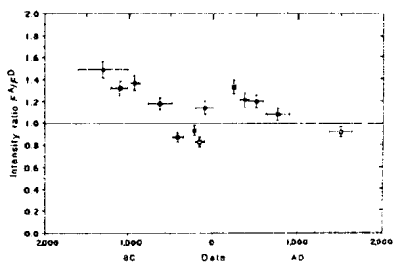 |
Science Frontiers ONLINE No. 54: Nov-Dec 1987 |
|
|
The changing magnetic climate: does it affect civilizations?
Abstract. "Past values for the geomagnetic intensity may be obtained by laboratory analysis of the thermoremanent magnetization carried by clay baked in ancient times. From global averages of such determinations it is commonly accepted that the intensity in any given region went through a broad maximum about 2000 years ago, reaching a level about 50% higher than at present. Here we present results obtained from a wide range of Chinese pottery, spanning the interval from 4000 BC to the present, indicating that the field behaviour was more complex. The intensity was high between 1500 and 1000 BC and again in the first half of the first millennium AD. Comparison with results reported for Western Asia, Egypt and Crete suggests that these high values are due to non-dipole disturbances in the geomagnetic field, consistent with long-term records of the cosmogenic radioisotopes 14C and 10Be."
(Quing-Yun, Wei, et al; "Geomagnetic Intensity as Evaluated from Ancient Chinese Pottery," Nature, 328:330, 1987.)
Comment. This article stimulates three questions:
- What caused the geomagnetic changes; could some be of internal origin?
- Are periods of reduced magnetic fields associated with cultural changes? The graph, for example, reveals a dip during the flowering of Greek civilization.
- Could such ambient magnetic changes have an effect on human imagination, as reported in laboratory test?. See SF#53.
 | Ratios of ancient geomagnetic field intensity to present intensity versus date. Data from China. |